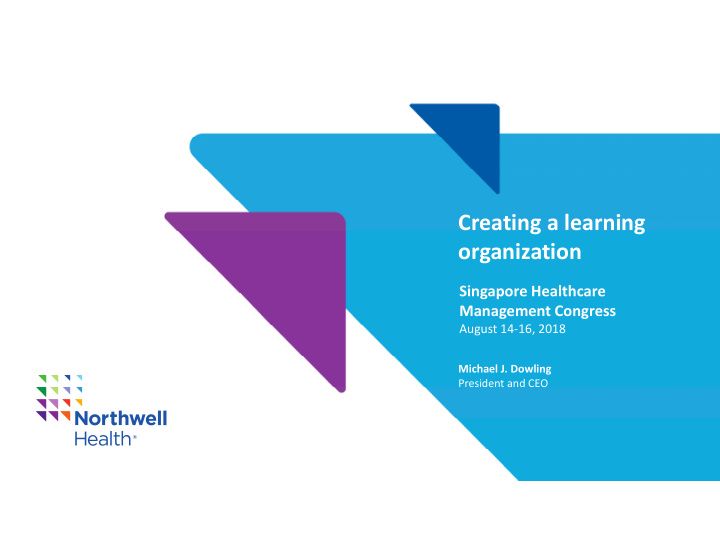



Creating a learning organization Singapore Healthcare Management Congress August 14 ‐ 16, 2018 Michael J. Dowling President and CEO
Success is all about people – an organization’s most valuable asset 2
A priority organizational goal • To create a first class organization of continuous learning • To build among employees the knowledge, attitude and skills necessary to support the strategic and business goals of the organization • To develop a cadre of leaders at all levels throughout the organization • To create and promote a system culture dedicated to excellence, innovation, teamwork and continuous change 3
Creating a culture of continuous learning basic principles • It’s a marathon – not a sprint • Learning is not the same as training – it has to be linked to strategy, to business goals • It’s a process without a finish line and be inseparable from work • It’s an investment – not a cost • Must be interdisciplinary, understand • It’s not a project on a series of matrix management, embrace initiatives – it must be interwoven as transparency, continually promote part of the organization’s DNA trust and organizational values • Structure is important; how it is • Talent exists and can be found and inaugurated; where it is located; nurtured at every level of the organization who it reports to • Learning “how to do” more important than • Leadership is key – right person; memorization right team 4
Northwell Health’s Center for Learning and Innovation LEADERSHIP PATIENT SAFETY PHYSICIAN SCHOLAR EMERGENCY BIOSKILLS CLINICAL DEVELOPMENT INSTITUTE (PSI) & LEADERSHIP PIPELINE MEDICAL EDUCATION TRANSFORMATION CLINICAL SKILLS INSTITUTE INSTITUTE CENTER CENTER Physician Beginnings Attending & Simulation Based Beginnings Administrative Evaluation & LEAN/Six Sigma Corporate Paramedic Program Resident Physician Education Corporate Fellowship Assessment Program Orientation Program Orientation Physician Administrative & Domestic & Emergency Medical Interprofessional Leadership Clinical Skills Continuing Medical Program/Project Clinical High International Technician (EMT) Team Education Development Education Education Management Potential Program Internships Program Program Hybrid Paramedic Leadership Educator Department New Yorkers for Large Scale Process & EMT Clinical Simulation Hybrid Simulation Development Development Specific Education Children Program Design/Redesign Recertification American Heart Procedural Skills Educational Department Team Medical Scholars Association Vendor Sponsored Clinical ALEAD Program Education at Research Building Pipeline Certification Programs Collaborations Bioskills Courses Pre ‐ hospital Military, FDNY & Clinical Education Institute for Health Industrial Workflow Testing Workflow Testing Continuing Medical Law Enforcement at PSI Professions Engineering Education Officers (LEO) Formative & Process Simulation Chief Resident IS 59 Summative & Optimization Education Partnership Assessment Modeling Physical Exam & Physician Implementation & Communication Administrative Change Skills Fellowship Management 5
Discussion A. Beginnings/On ‐ boarding G. Annual retreats B. Leadership development H. Town hall and direct employee meetings C. “High Potential” program I. Succession planning D. Clinical simulation J. Employee health and wellness E. Medical education F. Nursing leadership and education 6
7
Additional issues Avoid “silos” The importance of communication Especially among physicians, The danger of believing it has occurred • • nurses and administrators Focus on why; not just what Manage paradox and explain it Appeal to aspirations, wants, needs • Change vs. stability Employees desire to belong (to a cause) • • Risk vs. safety • Explain organizational dynamics Control vs. delegation, etc. • and structure Matrix management – lines of influence, • not just authority 8
“It is not enough to appeal to reason and logic. We must also appeal to the emotions.” ‐ Aristotle
Recommend
More recommend